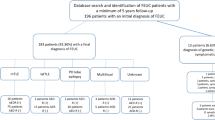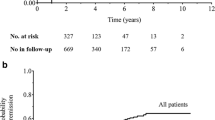Abstract
A multicenter prospective investigation was conducted in 17 teaching and general hospital in Italy to assess the efficacy of the care delivered to previously untreated patients with epilepsy. 175 cases were included and allocated to monotherapy. Only 112 cases completed the first year of follow-up. Of these, 59 (52.7%) were completely controlled and 53 (47.3%) had one or more seizure relapses. Controlied and uncontrolled patients were compared with respect to the main variables believed to influence non-responsiveness to standard therapy. The proportion of cases with relapses was significantly associated with the number of seizures reported before treatment was started. Selected seizure patterns (absences, myoclonic seizures) and prolonged disease duration were also reported more frequently among patients with recurrences. The implications of these findings are discussed with respect to drug response and prognosis of epilepsy.
Sommario
Il presente studio consiste in una indagine prospettica multicentrica condotta in 17 centri ospedalieri italiani sulla efficacia del trattamento e sulla prognosi della malattia in pazienti con epilessia alla prima diagnosi. Dei 175 casi ammessi allo studio, 112 hanno completato il primo anno di osservazione. Di questi, 59 (52,7%) risultavano completamente controllati e 53 (47,3%) avevano presentato una o più crisi durante il follow-up. Le principali variabili ritenute responsabili di una insoddisfacente risposta al trattamento vennero quindi esaminate nei due gruppi. Il rischio di recidiva di crisi risultava significativamente correlato al numero di crisi presentate prima del trattamento. Inoltre, i pazienti con crisi nel follow-up presentavano una maggior durata di malattia o specifici tipi di crisi (assenze, crisi miocloniche). Il significato di tali dati è discusso in riferimento alle modalità di trattamento e agli altri fattori implicati nella prognosi dell'epilessia.
Similar content being viewed by others
References
Rodin EA:Medical and social prognosis in epilepsy. Epilepsia 1972; 13:121–131.
Currie S, Heathfield KWG, Henson RA, Scott DF:Clinical course and prognosis of temporal lobe epilepsy. A survey of 666 patients. Brain 1971; 94: 173–190.
Sofijanov NG:Clinical evolution and prognosis of childhood epilepsies. Epilepsia 1982; 23:61–69.
The Group for the Study of prognosis of Epilepsy in Japan:Natural history and prognosis of epilepsy: Report of a multi-institutional study in Japan. Epilepsia 1981; 22:35–53.
Annegers JF, Jauser WA, Elveback LR:Remission of seizures and relapse in patients with epilepsy. Epilepsia 1979: 20:729–737.
Goodridge DMG, Shorvon SD:Epileptic seizures in a population of 6000. I: Demography, diagnosis and classification, and role of the hospital services. Br Med J 1983; 287:641–647.
Milano Collaborative Group for Studies on Epilepsy:Long-term intensive monitoring in the difficult patient. Preliminary results of 16 months of observations-Usefulness and limitations. In: Gardner-Thrope G, ed. Antiepileptic drug monitoring. Tunbridge Wells: Pitman, 1977:197–213.
Cawthorne IF, Silas JH:Impact of therapeutic audit on phenytoin prescribing. Br Med J 1981; 282: 1278.
Elwes RDC, Johnson AL, Shorvon SD, Reynolds EH:The prognosis for seizure control in newly diagnosed epilepsy. N Engl J Med 1982; 311: 944–947.
Camfield PR, Camfield CS, Smith EC, Tibbles JAR:Newly treated childhood epilepsy: A prospective study of recurrences and side effects. Neurology 1985; 35:722–725.
Mantel N, Haenszel W:Statistical aspects of the analysis of data from retrospective studies of disease. JNCI 1959; 22:719–748.
Strandjord RE, Johannessen SI:Carbamazepine as the only drug in patients with epilepsy: Serum levels and clinical effects. In: Johannessen SI, Morselli PL, Pippenger CE, Richens A, Schmidt D, Meinardi H, eds. Antiepileptic therapy: Advances in drug monitoring. New York: Raven Press, 1980: 229–235.
Shakir RA, Johnson RH, Lambie DG, Melville ID, Nanda RN:Comparison of sodium valproate and phenytoin as single drug treatment in epilepsy. Epilepsia 1981; 22:27–33.
Reynolds EH, Shorvon SD:Monotherapy or polytherapy for epilepsy? Epilepsia 1981; 22:1–10.
Covanis A, Gupta AK, Jeavons PM:Sodium valproate: Monotherapy and polytherapy. Epilepsia 1982; 23:693–720.
Shorvon SD, Reynolds EH:Early prognosis of epilepsy. Br Med J 1982; 285:1699–1701.
Gowers WR:Epilepsy and other chronic convulsive disorders. Edinburgh: Churchill, 1981.
Thomas MH:The single seizure. Its study and management. JAMA 1959, 169:457–459.
Johnson LC, LeBolt WL, Long MT, et al.:Diagnostic factors in adult males following initial seizures. Arch Neurol 1972; 27:193–197.
Cleland PG, Mosquera I, Steward WP, Foster JB:Prognosis of isolated seizures in adult life. Br Med J 1981; 283:1364.
Blom S, Heijbel J, Bergfors PG:Incidence of epilepsy in children: A follow-up study three years after the first seizure. Epilepsia 1978; 19:343–350.
Hauser W.A., Elving Anderson V, Leowenson RB, McRobertson SM:Seizure recurrence after a first unprovoked seizure. N Engl J Med 1982; 307: 522–528.
Holowach Thurston J, Thruston DL, Hixon BB, Keller AJ:Prognosis in childhood epilepsy. Additional follow-up of 148 children 15 to 23 years after withdrawal of anticonvulsant therapy. N Engl J Med 1982; 306:831–836.
Hirtz DG, Ellenberg JH, Nelson KB:The risk of recurrence of nonfebrile seizures in children. Neurology 1984; 34:637–641.
Porter RJ, Penry JK:Efficacy and choice of antiepileptic drugs. In: Meinardi H, Rowan AJ, eds. Advances in epileptology. Amsterdam: Swetz & Zietlinger, 1978:220–230.
Sherwin AL, Robb JP, Lechter M:Inproved control of epilepsy by monitoring plasma ethosuximide. Arch Neurol 1973; 28:178–181.
Lund L:Anticonvulsant effect of diphenylhydantoin relative to plasma levels. A prospective three-year study in ambulant patients with generalized epileptic seizurez. Arch Neurol 1974; 31:289–292.
Bonati M, Castelli D, Tgnoni G, Leone N, Perucca E:Controllo di qualità nella determinazione dei livelli ematici dei farmaci antiepilettici: risultati di una indagine condotta presso 41 laboratori ospedalieri italiani. Boll. Lega It. Epil. 1984; 47:5–7.
Author information
Authors and Affiliations
Rights and permissions
About this article
Cite this article
Di Mascio, R., Beghi, E., Sasanelli, F. et al. Early prognosis of epilepsy. Effects of treatment in the first follow-up year. Ital J Neuro Sci 7, 421–429 (1986). https://doi.org/10.1007/BF02283020
Issue Date:
DOI: https://doi.org/10.1007/BF02283020




